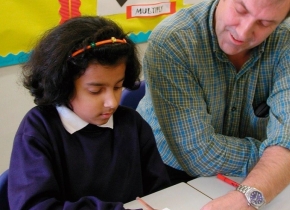
Request a full Catch Up® information brochure and details of our free information webinars
Find out more
Our trainers have a wealth of knowledge and experience outside their role as Catch Up® Accredited Trainers, and we have asked them to share some of that expertise with you. We hope you enjoy reading their hints and tips!
Welcome to the first of ‘Lynne’s logic’, where I hope you will find some useful tips to help you with your Catch Up® Numeracy support.
I try not to, but I find it hard not to eavesdrop on other people’s conversations, like the one recently between a group of teenagers complaining bitterly of teachers criticising errors in their grammar, punctuation and spelling. You can predict their defence, that spellcheck and predictive text mean they don’t need literacy skills, and I suppose I understand their thinking. However, being more number orientated, I began to wonder if they applied this thinking to number formation. Do they appreciate the importance of correct number formation? Possibly not.
Let’s think first about our expectations. Is it too much to ask primary-age children to form their mathematical writings correctly? There are the ten digits, the four operation signs, and the equal and the inequality symbols. Master these ten digits and your pupils can write any number possible. In conjunction with the other symbols, the world of calculations is at their fingertips. No, it is not too much to ask.
So how can we help children struggling to remember formation of the ten digits? You might try the ‘Naughty Nine’ rule. This rule applies to all the digits which are not symmetrical so must not be reversed; all digits except 8 and 0. The Naughty Nine rule says that these numbers are formed from left to right except, of course, for Naughty Nine, which is formed from right to left. Try it and see, it works! If needed, put a dot in the top left-hand corner of the page to remind a child which side most digits begin on. This should eliminate those reversals of 3s and 5s.
Writing from the bottom up can result in incorrectly-formed digits – 9, especially, will often resemble 4. To avoid this, practise on a vertical surface which will encourage a top-down formation.
What about transpositions? Confusing the tens and the units – or should I say tens and ones. For 14, writing 41, for example. Well, we do say the four part first, so it’s perfectly understandable to write the 4 first. The late Richard Dunne suggested the concept of using onety-one, onety-two and so on. This would certainly be logical and fit with the pattern of twenty-one, thirty-one and so on, however, I cannot see this becoming the norm. So how can we help?
Many of your pupils will have older brothers and sisters and I have found the ‘terrible teenagers’ a popular tip for youngsters. We all know how contrary teenagers can be, always wanting to be different, so relate this to the teen numbers. Just like their teenage brothers and sisters, teen numbers like to be different, so they are spoken with their digits the other way round to how they are written. A tip worth trying.
That’s all on number formation! Next time, Lynne’s logic will begin looking at the four processes.
Catch Up® is the working name of The Caxton Trust, a not-for-profit charity registered in England and Wales (1072425) and Scotland (SC047557) as well as a company limited by guarantee (03476510). Catch Up is a registered trademark.
The Catch Up® Web site use "cookies" to help you personalise your online experience. A cookie is a text file that is placed on your hard disk by a Web page server. Cookies cannot be used to run programs or deliver viruses to your computer. Cookies are uniquely assigned to you, and can only be read by a web server in the domain that issued the cookie to you.
Click on the different category headings below to find out more. You can change your default settings very easily. To turn cookies on, click the button to the right. To turn cookies off, click the buttons to the left. Please read our cookie policy to find out more.
Performance monitoring cookies: Google Analytics cookies (_ga,_gid) - these can last up to 2 years.
Strictly necessary cookies used by the site content management system: PHPSESSID (used to record your logged in session) and allow_cookies (used to record that the user has consented to cookies) - these are either temporary (session) cookies or expire after no more than 30 minutes and are used to provide functionality as you navigate around the site and allow you to access secure areas.